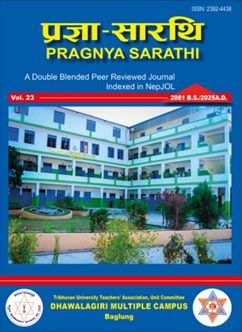Exploring Metaphorical Mechanism in Poetry
DOI:
https://doi.org/10.3126/ps.v23i1.77524Keywords:
Conceit, metaphorical devices, personification, simile, symbolAbstract
Poetry, as an art form, relies on the creative manipulation of language to evoke emotions, convey abstract ideas, and establish connections between disparate entities. This paper explores how the poets convey complex emotions and abstract concepts through the use of metaphorical devices. The study focuses on the poetic works, navigating from the poems by metaphysical poets like John Donne to the modern poetry of Emily Dickinson. It critically examines how metaphorical devices, such as simile, metaphor, personification, symbol, and conceit, enhance aesthetic quality, thematic depth and reader's engagement, contributing to the manifestation of abstract ideas and destabilization of meaning in poetry. Using qualitative research design, the article examines poetic expression through the lens of literary theories, including Formalism, Structuralism, Reader-Response Theory, cognitive metaphor theory and Deconstruction. The study includes relevant works by William Wordsworth, Wallace Stevens, Sylvia Plath, John Keats, Emily Dickinson, John Donne and others. The study contributes to the role of metaphorical devices in poetry, offering new perspective on how metaphorical devices shape poetic meaning. The article concludes that metaphorical devices are indispensable in poetry, enhancing both the aesthetic quality and interpretative depth of poetic works.
Downloads
Downloads
Published
How to Cite
Issue
Section
License
Copyright (c) 2025 The Author(s)

This work is licensed under a Creative Commons Attribution-NonCommercial 4.0 International License.
This license enables reusers to distribute, remix, adapt, and build upon the material in any medium or format for noncommercial purposes only, and only so long as attribution is given to the creator.




